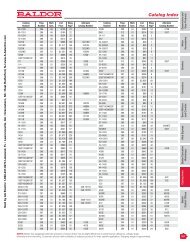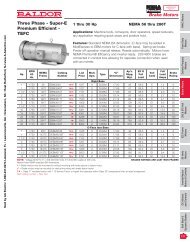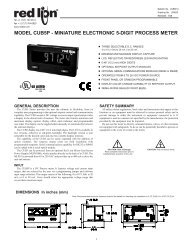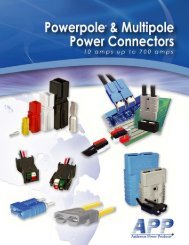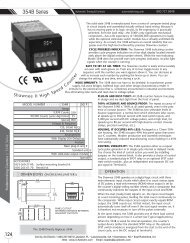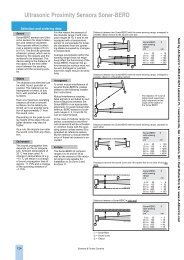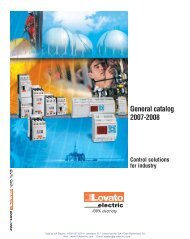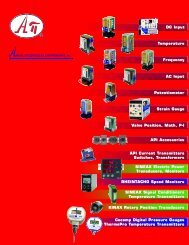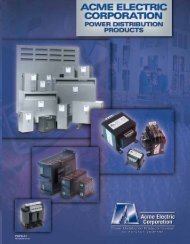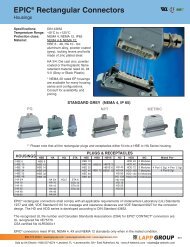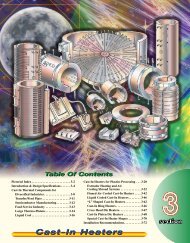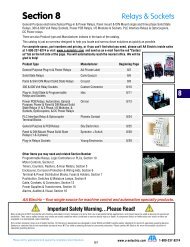G - AA Electric
G - AA Electric
G - AA Electric
Create successful ePaper yourself
Turn your PDF publications into a flip-book with our unique Google optimized e-Paper software.
Overvoltage protection for data interface<br />
Overvoltage protection<br />
I<br />
Principles of data transmission<br />
electrical<br />
system<br />
power supply<br />
I/O-lines<br />
datainterfaces<br />
bus lines<br />
Data transmission refers to the sending of<br />
characters, numbers, statuses, measurements<br />
etc. between various remote units.<br />
Remote units include controllers, computers,<br />
measurement transducers, actuators<br />
etc. One unit transmits while the other<br />
receives. This is the simplest form of data<br />
transmission.<br />
However, it is frequently necessary for one<br />
unit to receive something and then send<br />
an “answer” back to the other unit. To do<br />
this, we need two data lines that run backto-back,<br />
or we combine the data lines by<br />
providing a transceiver at each end of the<br />
data line.<br />
Structure and properties of networks<br />
There are various options for networking<br />
data terminal equipment. We distinguish<br />
between star type, ring, point-to-point and<br />
bus networks.<br />
Star-type networks<br />
The main unit is located in the centre. The<br />
individual data lines then radiate out from<br />
this centre to the individual terminal units.<br />
In other words, in star-type networks all<br />
data terminals are connected to the central<br />
terminal via their own cable.<br />
Ring networks<br />
The computers or data terminals are all<br />
connected to each other like a chain by<br />
means of a coaxial cable, for example. In<br />
this case the data are passed on from one<br />
data terminal to the next. The entire ring is<br />
therefore always under load. Advantage of<br />
the ring network: it can cover a larger area<br />
than a star-type network, because the<br />
transmission distance between 2 adjacent<br />
terminals is defined as the transmission<br />
path.<br />
Point-to-point networks<br />
These are basically networks between to<br />
data terminals that are connected directly<br />
with each other, e.g. an RS 232 or RS<br />
422 link.<br />
Bus systems<br />
These are networks based on the parallel<br />
connection of modules. All components<br />
operate on one and the same line.<br />
Therefore only two/four cores are<br />
required for the data bus. If bus cabling<br />
includes branches, then we call this a<br />
tree structure. Every bus system includes<br />
a bus controller that issues transmission<br />
permission to the individual terminals.<br />
Transmission media<br />
Data lines are necessary to transmit data:<br />
Two/three core systems<br />
Two-core systems are used for data<br />
transmission requiring relatively low<br />
transmission rates. For example, an ISDN<br />
system acting as an exchange line in a<br />
building only needs two cores. Other<br />
types of bus system also only use two or<br />
three cores.<br />
Four core systems<br />
This is the current standard for the<br />
majority of corporate data networks. Two<br />
cores are used for transmitting data and<br />
two for receiving. The cables are well<br />
shielded and can transmit data with frequencies<br />
of up to 500 MHz over distances<br />
of up to 100 m.<br />
Coaxial cable<br />
The technique of sending data via coaxial<br />
cables is relatively old and rarely used,<br />
given the slow speed and lack of flexibility<br />
of the networks. Transmission rates of<br />
12 Mbit/s today are no longer adequate.<br />
Over longer distances, fibre-optic cables<br />
are replacing coaxial cables; these can<br />
transmit several hundred Mbit/s.<br />
Serial interface<br />
A serial interface operates with 8 data bits<br />
(1 byte). A start bit (low bit) is always sent<br />
before the output of a byte, and one or<br />
two stop bits (high bit) are added to the<br />
end of the byte. This encryption is important<br />
for the data receiver as it can then<br />
detect where each data byte begins and<br />
ends. Serial interfaces frequently operate<br />
with +5V (logic 1) and 0V (logic 0).<br />
Advantage: less cabling (only 3 cores).<br />
Disadvantage: slow data transmission.<br />
RS232<br />
Serial interface for point-to-point connections<br />
of up to 20 kbit/s.<br />
Voltage signals to earth:<br />
logic 1 (mark) –15V to –3V<br />
logic 0 (space) +3V to +15V<br />
max. signal level +/- 15V<br />
Lines up to 20 m long depending on transmission<br />
rate<br />
RS422<br />
Serial unidirectional high-speed interface<br />
for up to 10 parallel receivers.<br />
Differential voltage signal:<br />
logic 1 (mark) A-B < -0.3V<br />
logic 0 (space) A-B > +0.3V<br />
max. signal level +/- 12 V<br />
Lines up to 1200 m long<br />
max. data rate 10 Mbit/s<br />
RS485<br />
Serial bidirectional high-speed interface for<br />
up to 32 subscribers<br />
2 or 4 core system<br />
Differential voltage signal:<br />
logic 1 (mark) A-B –0.3V<br />
logic 0 (space) A-B > +0.3V<br />
max. signal level –7V to +12V<br />
Lines up to 1200 m long<br />
max. data rate 10 Mbit/s<br />
LON (twisted pair)<br />
Series bus with TP/XF –78 (old)<br />
Series bus with TP7XF-1250<br />
Series bus or free topology with TP/FT 10<br />
Series bus or free topology with LPT-10<br />
EIB (European Installation Bus)<br />
Twisted pair or power line<br />
Series, star-type or tree bus (also combinations<br />
thereof) 9600 Bit/s<br />
Building services automation<br />
Sold by <strong>AA</strong> <strong>Electric</strong> 1-800-237-8274 Lakeland, FL • Lawrenceville, GA • Greensboro, NC • East Rutherford, NJ www.A-Aelectric.com<br />
I.64



